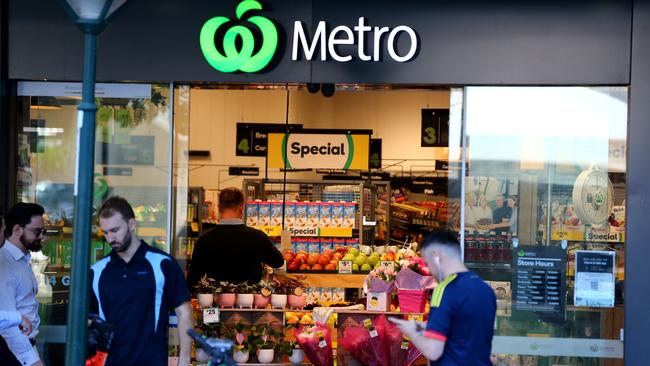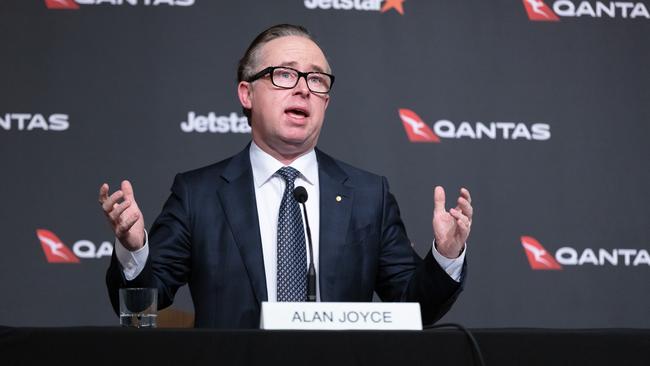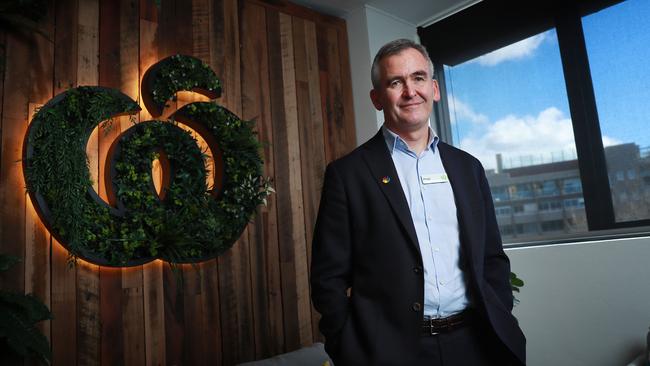Qantas and Woolworths a snapshot of Covid’s impact on business

Qantas announced a $2.3bn net loss in what Joyce calls a diabolic 12 months. By the end of this year, border closures will have cost Qantas $20bn in revenue. Behind the numbers are thousands of jobs losses. “I don’t think there is another company in Australia that has been impacted as much,” he said.
Woolworths announced a $2.1bn profit, a $2bn buyback and a dividend up 15 per cent on the year. Food sales in the first eight weeks of this year grew 4.5 per cent, powered by the shutdown in NSW where Woolies is strongest. The group also enjoyed lockdown earnings from Endeavour Drinks: a last special dividend from before the demerger.
Curiously, Qantas shares rose 3.5 per cent on the day and for two reasons.
First is Joyce’s ability to reposition the airline for Australia’s “Freedom Day”. He is already ahead on the target of $1bn in annual cost savings by 2023 and brought debt back from $6.4bn to $5.9bn in the second half. The Loyalty engine is purring, with 200,000 new members, and freight made record profits.
In the domestic market, by managing to reschedule every few days instead of twice a year, domestic flying has been 95 per cent cash-positive. Qantas’s market share in Australia has risen from about 60 per cent to 70 per cent, which Joyce says has never been clearer or stronger strategically. In the higher margin corporate end, demand jumped back to 75 per cent of pre-Covid-19 levels and the airline won 34 new corporate accounts.
The flagship airline is the public company leading on mandatory vaccines for its staff, 80 per cent of whom are already vaccinated. Significantly, Joyce says 75 per cent of them believe mandatory vaccines are the key to a safe workplace. The Prime Minister has backed Joyce in his mandatory vaccine strategy. “They’ve shown I think the right model to go about this,” Scott Morrison said.
Joyce has stuck his neck out many times to drag Australia forward, from industrial relations to marriage equality. Vaccine strategy is pivotal to the second reason the shares went up.
Alan Joyce has set a target for restarting international flights to LA, London and other high vaccinated destinations by mid-December, pinned to the federal government’s opening plan: domestic borders to open when a 70 per cent vaccination rate is reached and international borders at 80 per cent.

Five A380 aircraft will be flown back from hibernation in the Mojave Desert ahead of schedule and will be back flying Sydney to LA from July 2022, and Sydney-Singapore-London from November 2022.
Alan Joyce says the federal government has told Qantas the assumptions behind the airline’s plans are reasonable.
Invoking the “Spirit of Australia” with a new heartstring-pulling vaccine ad, Joyce is dialling up the pressure on premiers and especially Mark McGowan in Western Australia.
“It would be a terrible shame if we got to Christmas and in NSW you could visit your relations in London but can’t visit relatives in Perth. Hopefully we can get some consistency when national cabinet pushes through to opening up Australia and for us not to be a hermit nation going forward,” Joyce said.
Qantas’s 320 repatriation flights — carrying Aussies back from Europe and the US — were predominantly via Darwin, where the airline has developed operational capability. “If the only option to operate London flights is to be in Darwin, we think we are very capable of doing that.” And that includes a long-term consideration around lounges.
One tricky scenario that could emerge is if NSW jumps ahead to 80 per cent vaccination but domestic borders remain shut. While Qantas’s bigger business is domestic, and more staff would be back at work, it’s hard to think Joyce would say no to running international flights again out of Sydney.
Internationally, people are flying. What was interesting about Flight Centre’s results on Thursday was that the monthly cash burn of $30m to $40m in its second half came mainly from the Australian business. Its US business is now approaching cashflow-neutral.
At Woolworths Brad Banducci is using the Covid-19 bump in sales to drive his growth strategy hard, with $2bn in capital expenditure this year. That is unlikely to be the peak as Woolworths invests in big upgrades in the supply chain, which Banducci believes will drive future returns. “We think we can make it work both for our shareholders that want a dividend as well as those who are more towards growth.”

Left with a robust balance sheet after the Endeavour Drinks demerger and the acquisition of 55 per cent of food services business PFD, Banducci wants to invest ahead of the curve. Woolworths’ investment at the Moorebank Intermodal Terminal in Sydney is $1.25bn. “It’s the biggest capex investment outside of M&A that I’ll ever be involved in, I suspect,” he said. “This is the year we break ground developing a national semi-automated distribution centre and then a fully automated regional DC — and I wouldn’t underplay the strategic importance of our new fresh DC in Sydney.”
When the lockdowns eventually lift, Brad Banducci expects a few weeks of rushing to restaurants but then a return to old consumer patterns. What is changing is lunch as a meal, with more working from home, and a permanent lift in digital. The entire supply chain from source to home delivery must be as seamless as possible. “It’s a really important part of who we are and how we can differentiate ourselves against other competitors in this world of ecosystem-based retailing.”
Banducci says one thing the supermarket will need to get used to is higher international freight costs, which are up 20-30 per cent and unlikely to come down even after borders open. That is some consolation for Alan Joyce.







The Qantas and Woolworths results on Thursday present a confronting picture of what the last 12 months has done to business. Adapting to Covid-19 for Alan Joyce and Brad Banducci, two of Australia’s most senior business leaders, could not have been more different.